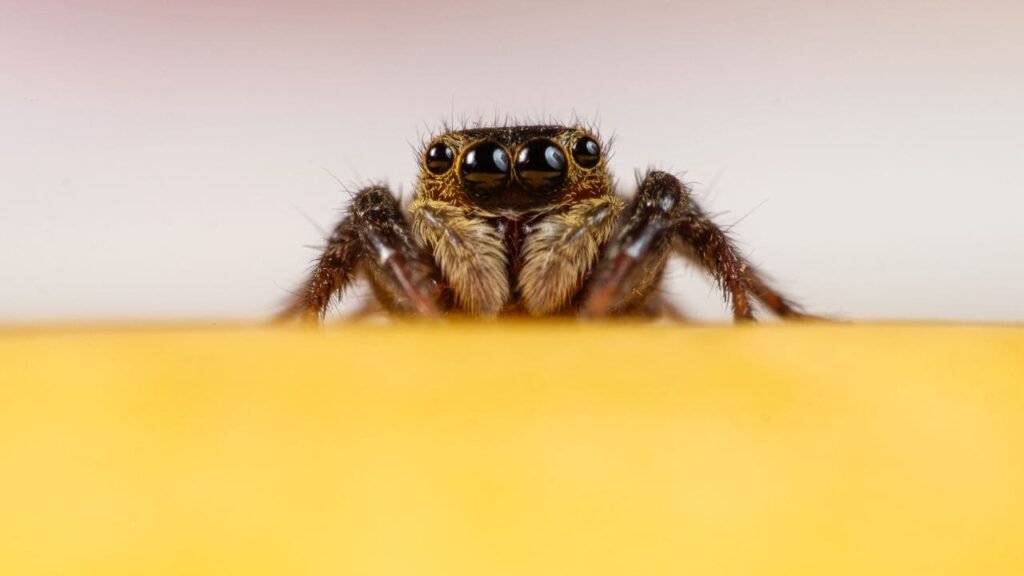


Jumping spiders have become incredibly popular lately, capturing the fascination of millions with their surprisingly cute demeanor and friendly behavior towards humans. As videos of these tiny 8-legged creatures exploring and interacting with their owners go viral on social media, more people are wondering — how much do jumping spiders cost to properly care for as unusual yet endearing pets?
With conflicting information about spider costs across the internet, getting clear and realistic answers can be difficult for prospective jumping spider owners. That’s why I’ve created this comprehensive guide breaking down the real-world expenses of purchasing and maintaining one of these unique arachnid pets over their 1-3 year lifespan. Read on to finally learn the shocking truth about jumping spiders’ price tags!
But first, let’s go over what exactly jumping spiders are for those new to the concept of spider custody. There are over 5,000 jumping spider species globally, most measuring just 6-22mm long as adults. These aptly named arachnids get their common name from their incredible ability to leap up to 10 times their body length!
Jumping spiders have excellent vision from their two large front eyes, and 4-6 smaller secondary eyes also provide nearly 360 degrees expanded sensory perception. Using this specialized vision instead of traditional webs, jumping spiders actively hunt by stalking close to their prey before attacking with lightning quick speed and agility.
Unlike other more intimidating crawlies, jumping spiders often exhibit incredibly curious, sometimes downright friendly behavior with their human caretakers. Their apparent intelligence and fuzzy faces have made them unlikely internet superstars. For experienced spider handlers not afraid of their 8-legged nature, jumping spiders make perfect low maintenance yet endlessly fascinating pets with their cute looks and captivating personalities putting them in a class of their own in the exotic animal custody world.
Now let’s investigate the costs that buying, housing, feeding and properly caring for one of these personable predators truly entails.

The first expense that comes with preparing for any type of unusual pet custody is procuring an actual spider itself. Captive bred specimens of popular jumping spider species can be purchased either from local specialty breeders/pet stores in some regions, or more commonly online.
Prices typically range anywhere from $20 on the very low end, up to $75 or more per spider depending on variables like age, sex, coloring, species and rarity. Mature adult females often demand the highest prices due to higher demand stemming from their frequently bolder patterns, intriguing reproductive behaviors, and central role in breeding projects.
Some of the most common types of jumping spiders kept as pets include:
When searching locally, prospective jumping spider owners may get lucky and find breeders offering slighly cheaper prices than the larger online sellers can afford to. However you do risk more variability in overall spider health, age accuracy claims, and ethical breeding practices through less specialized local sources.
For these reasons, I strongly recommend purchasing your spider online through reputable jumping spider breeders even if costs are potentially marginally higher to start. Paying a bit more eliminates a lot of risks associated with finding cheaper local spiders from less qualified sources.
| Spider Species | Approx. Cost Range (USD) | Max Size | Ideal Habitat Size | Skill Level | Considerations |
|---|---|---|---|---|---|
| Regal Jumping Spider | $35 – $75 | 6 – 22 mm | 6 x 6 x 8 inches+ | Easy | Docile, handleable for beginners |
| Bold Jumping Spider | $25 – $60 | 8 – 18 mm | 4 x 4 x 6 inches+ | Easy | Can be skittish but very agile |
| Canopy Jumping Spider | $20 – $50 | 8 – 18 mm | 4 x 4 x 6 inches+ | Easy | Loves to climb, watch humidity |
Beyond the actual live spider itself, the next major expense for jumping spider ownership comes from procuring and outfitting a proper enclosure and habitat accessories suited to their needs. Some items commonly required for most jumping spider enclosures include:
Enclosure Options
Habitat Accessories
For beginners, I strongly encourage simple DIY habitats made from typical household items like clear plastic containers found around the home. Holes poked in the sides provide ample ventilation, while materials like decorative stones, fake plants and sticks from outside make perfect decor and enrichment at almost no financial cost.
Easy, basic DIY setups under $20 total are completely suitable homes for starter jumpers. As your skills grow, consider upgrading to more visually appealing displays with proper lighting and themeing – but avoid overspending just for looks alone. Function over form is key with exotic pet habitats!
As carnivorous predators, providing your jumping spider a continual supply of live feeder insects is completely essential to their health and happiness in captivity. The cumulative costs of purchasing adequate feeder quantities to properly nourish your spider for its entire 1-3 year adulthood lifespan may shock some first time owners though!
Common staples of most jumping spiders’ diets include:
Savvy spider owners minimize expenses via methods like culturing their own colonies of flightless fruit flies or pinhead crickets to tap into continual, self-replenishing feeder stock. But beginners should expect consistent feeder insect expenses of $10-$30 per month at minimum to keep their jumper well fed.Certain premium worms like hornworms should be offered only as occasional treats due to their higher costs.
Buying feeder insects in larger bulk quantities rather than small pet store cups brings average per-insect prices down substantially too. An investment up front in 1000+ mealworms keeps costs lower over time after establishing your spider friend!

Though quite hardy and resilient once settled into captivity, jumping spiders can occasionally battle external issues like mites, intestinal parasites, dangerous mold or bacterial blooms on their decor and cage furnishings, etc. Depending on the severity, these conditions may require specialized veterinary diagnosis and care for full recovery.
Visiting an exotic animals focused veterinarian generally costs a flat fee of $40+ per appointment, not counting any additionally prescribed medications ranging $5-30+. While actual medication is rarely needed for jumping spiders, establishing an emergency vet trip fund of $100-$150 can save your beloved companion’s life if drastic issues emerge.
So factor in a bit of budget padding for unexpected veterinary costs beyond your spider and feeding insects baseline expenses. Catching subtle health issues early makes treatment easier on both your wallet and your treasured jumper!
Outside of habitat furnishings, feeder creepy crawlies, and vet trip financial prepping, a few additional supplementary supplies will keep your jumping spider at peak fitness throughout adulthood. Common spider owner purchases in this miscellaneous realm include:
While not strictly monthly necessities, budget around $15-$25 for occasional Miscellaneous supplies in accessory or decoration replacement, water additive replenishment, etc over each 3-6 month period. Some purchases like cleaning products or transport carriers will last 1-2+ years however before needing replacements!
So after tallying up all the potential costs, what spending range can prospective jumping spider owners expect to invest overall? Here is a quick breakdown:
Best Case Scenario
Worst Case Scenario
Realistically, most owners end up spending $125-$225 overall at start for a good quality jumper, properly outfitted habitat, initial feeders and transport gear. After that expect $20-$45 in recurring monthly costs for continual food and replacements. Monthly costs scale down for younger spiders too.
Compared to traditional caged pets, these cost ranges still qualify jumping spiders as very wallet friendly companions! By following the money saving tips below, spider custody can work even on strict budgets!
| Spider Age | Food Cost | Supplements/Misc Cost | Habitat Costs | Total Monthly Cost |
|---|---|---|---|---|
| Baby (0-3 months) | $5 – $10 | $2 – $5 | $0 | $10 – $20 |
| Juvenile (3-9 months) | $10 – $15 | $2 – $5 | $5 – $10* | $20 – $25 |
| Adult (10-18 months) | $15 – $30 | $5 – $10 | $0 – $10** | $25 – $40 |
Here are some helpful tips for reducing overall spider expenditures without sacrificing proper care:
While costs inevitably add up quicker for more unusual pets like spiders, implementing thrifty tricks like these helps keep overall jumping spider custody surprisingly affordable compared to traditional mammalian and avian pets with intensive needs!

As with any pet though, assess your overall readiness to take stewardship over another living creature before seeking out your first jumping spider. Truthfully consider factors like:
No pet should be an impulse acquirement before seriously weighing required duties of properly caring for them for the duration of ownership! Be realistic about the commitments involved before adopting your first jumping spider.
If after digesting all the included jumping spider cost, care, and commitment advice shared above you still wish to open your home to one of these charismatic creatures, congratulations! Finding a personally compatible 8-legged friend awaits. Here are my top tips for a smooth adoption process and transition home once you spot “The One”:
I always suggest allowing at least 30 minutes at the shop or breeder to gently interact with any prospective spider directly. Often personality differences shine through while handling, so take time assessing potential fits.
When arranging transport logistics for online/non local purchases, read up thoroughly in advance on any live arrival guarantees, recommended shipping seasons and practices, etc that your seller provides. Don’t be afraid to ask clarifying questions either! Established sellers will happily educate about their processes and policies.
Regardless of acquisition source, carefully acclimate new jumpers once home. Limit initial handling for the first few days; offer treats like mealworm chunks via long tweezers to build positive associations at a comfortable distance in their new environment. Speak gently when working around the enclosure and leave soft music on to start establishing calm bonding vibes during this sensitive transition phase while they destress from travel.
Soon you’ll discover for yourself the reasons internet communities embrace these tiny jumping spiders as darling pets – Their shockingly endearing personalities and brains win over even lifelong committed arachnophobes! Welcome to the wonderful world of jumping spider custody! Let me know your experiences or questions in the comments section below!
Do jumping spiders make good pets for beginners or children?
Jumping spiders can make fantastic starter pets even for responsible older children or novice arachnid owners. Their small size, low maintenance needs, and friendly personalities when habituated make them one of the most easygoing spider species to keep. However, very young children may need supervision and assistance with care tasks.
What are the recurring costs per month after the initial habitat purchase?
Expect monthly costs between $20-$45 on average depending on your spider’s age and appetite. This covers fresh feeder insect purchases, occasional habitat accessories like new foliage, moisture supplements, etc. Monthly costs are highest for adult spiders actively breeding.
Can a jumping spider habitat be safely kept in a bedroom?
Absolutely! A well-sealed tank or enclosure located on a steady dresser or shelf is perfectly safe inside bedrooms. Just be very careful when opening the habitat for feeding/maintenance to avoid escapes into living spaces if arachnophobic individuals share that bedroom.
How often do jumping spiders need to visit an exotic vet?
Healthy jumping spiders rarely need vet visits under proper care and husbandry. However, it’s smart to find an experienced exotic animals vet nearby and budget around $100-$150 total in case immediate treatment is ever required for injuries or sudden illnesses.
What tips maximize lifespan for my jumper?
Focus on providing proper heating/lighting, a consistent feeding schedule 3x weekly, spot cleaning waste right away, and gentle handling for socialization/bonding. Also mix up feeder insects for balanced nutrition. Good care rewards you with 1-3 wonderful years with your beloved spider!